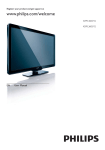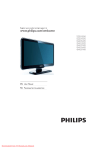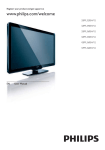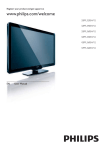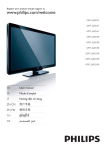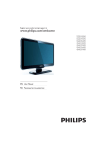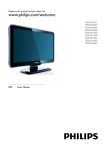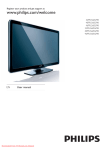Download Philips 3000 series 32PFL3205 32" HD-Ready
Transcript
Register your product and get support at www.philips.com/welcome 32PFL3605/12 42PFL3605/12 32PFL3205/12 EN User Manual Model Serial www.philips.com/support Österreich 0800 180 016 België/Belgique 80080190 България 00800 11 544 24 Hrvatska 01 6403 776 Česká republika 800142840 Bezplatný hovor Danmark 3525 8759 Lokalt opkald Lokalni poziv Estonia 6008600 kohalik kõne tariifi Suomi 09 2311 3415 paikallispuhelu France 0805 025 510 numéro sans frais Deutschland 0800 000 7520 gebührenfreier Anruf Ελλάδα 0 0800 3122 1280 Κλήση χωρίς χρέωση Magyarország 0680018189 Ingyenes hívás Hrvatska 0800 222778 free Ireland 01 601 1777 Italia 800 088774 Numero Verde Қазақстан +7 727 250 66 17 local Latvia 52737691 local Lithuania 67228896 local Luxemburg/Luxembourg 40 6661 5644 Ortsgespräch/Appel local Nederland 0800 0230076 Gratis nummer Norge 22 70 81 11 Lokalsamtale Polska 00800-311-13-18 Pozosta?e produkty RTV oraz AGD Portugal 800 780 903 Chamada Grátis România 0800-894910 0318107125 Apel gratuit Apel local Россия (495) 961-1111 0.15 USD/minute Србија +381 114 440 841 Lokalni poziv Slovensko 0800 004537 Bezplatný hovor Slovenija 00386 12 80 95 00 lokalni klic España 900 800 655 Teléfono local gratuito solamente para clientes en España Sverige 08 5792 9100 Lokalsamtal Suisse/Schweiz/Svizzera 0800 002 050 Schweizer Festnetztarif/ Tarif réseau fixe France Türkiye 0800 261 3302 Şehiriçi arama United Kingdom General No: 0800 331 6015 General National Rate No: 0870 911 0036 free National rate Україна 0-800-500-697 This information is correct at the time of press. For updated information, see www.philips.com/support. 7 Connect devices 1 Notice 2 2 Important 4 3 Your TV 7 7 7 Side controls and indicators Remote control 4 Use your TV Switch your TV on / off or to standby Switch channels Watch connected devices Adjust TV volume Use teletext 5 Use more of your TV Access TV menus Rename devices from the home menu Remove devices from the home menu Change picture and sound settings Use advanced teletext features Create and use list of favourite channels Use the TV clock Use timers Use TV locks View photos and play music from a USB storage device Update the TV software Change TV preferences Access decoder channel Start a TV demo Reset the TV to factory settings 6 Install channels Automatically install channels Manually install channels Rename channels Rearrange channels 25 25 27 28 29 30 Back connector Side connector Connect a computer Use Philips EasyLink Use a Kensington lock 8 Product information 9 9 9 10 10 10 11 11 11 11 12 14 15 16 16 17 31 31 31 31 31 31 31 32 Supported display resolutions Multimedia Tuner / Reception / Transmission Remote control Power Supported TV mounts Product specification 9 Troubleshooting 33 33 33 34 34 34 35 35 General TV issues TV channel issues Picture issues Sound issues HDMI connection issues Computer connection issues Contact us 10 Index 36 18 20 20 21 21 21 22 22 22 24 24 EN 1 E n g l i sh Contents 1 Notice 2010 © Koninklijke Philips Electronics N.V. All rights reserved. Specifications are subject to change without notice. Trademarks are the property of Koninklijke Philips Electronics N.V or their respective owners. Philips reserves the right to change products at any time without being obliged to adjust earlier supplies accordingly. The material in this manual is believed adequate for the intended use of the system. If the product, or its individual modules or procedures, are used for purposes other than those specified herein, confirmation of their validity and suitability must be obtained. Philips warrants that the material itself does not infringe any United States patents. No further warranty is expressed or implied. Warranty • Risk of injury, damage to TV or void of warranty! Never attempt to repair the TV yourself. • Use the TV and accessories only as intended by the manufacturer. • The caution sign printed on the back of the TV indicates risk of electric shock. Never remove the TV cover. Always contact Philips Customer Support for service or repairs. • 2 Any operation expressly prohibited in this manual, or any adjustments and assembly procedures not recommended or authorised in this manual shall void the warranty. EN Pixel characteristics This LCD product has a high number of colour pixels. Although it has effective pixels of 99.999% or more, black dots or bright points of light (red, green or blue) may appear constantly on the screen. This is a structural property of the display (within common industry standards) and is not a malfunction. Compliance with EMF Koninklijke Philips Electronics N.V. manufactures and sells many products targeted at consumers which, like any electronic apparatus, in general have the ability to emit and receive electromagnetic signals. One of Philips’ leading Business Principles is to take all necessary health and safety measures for our products, to comply with all applicable legal requirements and to stay well within the EMF standards applicable at the time of producing the products. Philips is committed to develop, produce and market products that cause no adverse health effects. Philips confirms that if its products are handled properly for their intended use, they are safe to use according to scientific evidence available today. Philips plays an active role in the development of international EMF and safety standards, enabling Philips to anticipate further developments in standardisation for early integration in its products. Mains fuse (UK only) This TV is fitted with an approved moulded plug. Should it become necessary to replace the mains fuse, this must be replaced with a fuse of the same value as indicated on the plug (example 10A). 1 2 Remove fuse cover and fuse. The replacement fuse must comply with BS 1362 and have the ASTA approval mark. If the fuse is lost, contact your dealer in order to verify the correct type. 3 Refit the fuse cover. In order to maintain conformity to the EMC directive, the mains plug on this product must not be detached from the mains cord cable. E n g l i sh Copyright ® Kensington and Micro Saver are registered US trademarks of ACCO World corporation with issued registrations and pending applications in other countries throughout the world. HDMI, the HDMI logo and High-Definition Multimedia Interface are trademarks or registered trademarks of HDMI Licensing LLC. All other registered and unregistered trademarks are the property of their respective owners. EN 3 2 Important Read and understand all instructions before you use your TV. If damage is caused by failure to follow instructions, the warranty does not apply. Safety Risk of electric shock or fire! • Never expose the TV to rain or water. Never place liquid containers, such as vases, near the TV. If liquids are spilt on or into the TV, disconnect the TV from the power outlet immediately. Contact Philips Consumer Care to have the TV checked before use. • Never place the TV, remote control or batteries near naked flames or other heat sources, including direct sunlight. To prevent the spread of fire, keep candles or other flames away from the TV, remote control and batteries at all times. • Never insert objects into the ventilation slots or other openings on the TV. • When the TV is swivelled ensure that no strain is exerted on the power cord. Strain on the power cord can loosen connections and cause arcing. Risk of short circuit or fire! • Never expose the remote control or batteries to rain, water or excessive heat. • Avoid force coming onto power plugs. Loose power plugs can cause arcing or fire. 4 EN Risk of injury or damage to the TV! • Two people are required to lift and carry a TV that weighs more than 25 kg. • When stand mounting the TV, use only the supplied stand. Secure the stand to the TV tightly. Place the TV on a flat, level surface that can support the combined weight of the TV and the stand. • When wall mounting the TV, use only a wall mount that can support the weight of the TV. Secure the wall mount to a wall that can support the combined weight of the TV and wall mount. Koninklijke Philips Electronics N.V. bears no responsibility for improper wall mounting that result in accident, injury or damage. Risk of injury to children! Follow these precautions to prevent the TV from toppling over and causing injury to children: • Never place the TV on a surface covered by a cloth or other material that can be pulled away. • Ensure that no part of the TV hangs over the edge of the surface. • Never place the TV on tall furniture (such as a bookcase) without anchoring both the furniture and TV to the wall or a suitable support. • Educate children about the dangers of climbing on furniture to reach the TV. Risk of overheating! • Never install the TV in a confined space. Always leave a space of at least 4 inches or 10 cm around the TV for ventilation. Ensure curtains or other objects never cover the ventilation slots on the TV. Risk of damage to the TV! • Before you connect the TV to the power outlet, ensure that the power voltage matches the value printed on the back of the TV. Never connect the TV to the power outlet if the voltage is different. Disposal of your old product and batteries E n g l i sh Risk of injury, fire or power cord damage! • Never place the TV or any objects on the power cord. • To disconnect the TV power cord easily from the power outlet, ensure that you have full access to the power cord at all times. • When you disconnect the power cord, always pull the plug, never the cable. • Disconnect the TV from the power outlet and antenna before lightning storms. During lightning storms, never touch any part of the TV, power cord or antenna cable. Risk of hearing damage! • Avoid using earphones or headphones at high volumes or for prolonged periods of time. Low temperatures • If the TV is transported in temperatures below 5°C, unpack the TV and wait until the TV temperature matches room temperature before connecting the TV to the power outlet. Your product is designed and manufactured with high quality materials and components, which can be recycled and reused. When this crossed-out wheeled bin symbol is attached to a product it means that the product is covered by the European Directive 2002/96/EC. Please inform yourself about the local separate collection system for electrical and electronic products. Please act according to your local rules and do not dispose of your old products with your normal household waste. Correct disposal of your old product helps to prevent potential negative consequences for the environment and human health. Screen care • • • • • Avoid stationary images as much as possible. Stationary images are images that remain on-screen for extended periods of time. Examples include: on-screen menus, black bars and time displays. If you must use stationary images, reduce screen contrast and brightness to avoid screen damage. Unplug the TV before cleaning. Clean the TV and frame with a soft, damp cloth. Never use substances such as alcohol, chemicals or household cleaners on the TV. Risk of damage to the TV screen! Never touch, push, rub or strike the screen with any object. To avoid deformations and colour fading, wipe off water drops as soon as possible. Your product contains batteries covered by the European Directive 2006/66/EC, which cannot be disposed with normal household waste. Please inform yourself about the local rules on separate collection of batteries because correct disposal helps to prevent negative consequences for the environmental and human health. EN 5 Energy efficiency features • Ambient light sensor (Available in selected models only) To save energy, the built-in Ambient light sensor lowers the brightness of the TV screen when the surrounding light darkens. • Energy saving The energy saving setting of the TV combines several TV settings that result in saving energy. See the smart settings in the setup menu. • Low standby power consumption The class-leading and highly advanced power circuitry brings down the power consumption of the TV to an extremely low level, without losing out on the constant standby functionality. Power management (Available in selected models only) The advanced power management of this TV ensures the most efficient use of its energy. You can check how your personal TV settings, the level of brightness in current onscreen pictures and the surrounding light conditions determine the relative power consumption. End of use To inform yourself on the correct disposal of the TV and batteries, refer to ‘Disposal of your old product and batteries’ in the user manual (see ‘Disposal of your old product and batteries’ on page 5). 6 EN 3 Your TV Congratulations on your purchase, and welcome to Philips! To fully benefit from the support that Philips offers, register your TV at www.philips.com/welcome. 1 2 22 21 20 This section gives you an overview of commonly used TV controls and functions. E n g l i sh Remote control 19 3 4 5 6 7 8 Side controls and indicators 18 9 17 10 11 16 12 1 2 3 13 4 5 a +/-: Increases or decreases volume. b (Home): Toggles the home menu on or off. 15 14 c P/CH +/-: Switches to the next or previous channel. d (Power): Switches the product on or off. The product is not powered off completely unless it is physically unplugged. e Standby indicator and remote control sensor. EN 7 a • • b (Standby-On) Switches the TV to standby if it is on. Switches on the TV if it is in standby. MENU Toggles the main menu on or off. c MHEG/TELETEXT Toggles teletext on or off. d SOURCE Selects connected devices. o SOUND (Smart Sound) Launches the sound menu. p +/- (Volume +/-) Increases or decreases volume. q • • r e Colour buttons Selects tasks or options. f AD (Audio Descriptor) (For RF Digital TV only) UK only: Enables audio commentary for the visually handicapped. g OPTIONS Accesses options relating to the current activity or selection. h OK Confirms an entry or selection and displays the channel grid, when watching TV. i BACK P/P (Previous channel) Returns to a previous screen. Returns to the previously viewed channel. GUIDE Switches between channel grid and programme list. s SUBTITLE (For RF Digital TV only) Enables or disables subtitles. t DEMO (Used in selected models only) Toggles the demonstration menu on or off. u FORMAT Selects a picture format. v INCR. SURR Enables Incredible Surround for stereo sources. Enables spatial mode for mono sources. (Navigation buttons) Navigates menus. Remote control usage j INFO Displays program information, when available. If the information spans multiple pages, press OPTIONS to go to the next page. When using the remote control, hold it close to the TV and point it at the remote control sensor. Make sure that the line-of-sight between the remote control and TV is not blocked by furniture, walls or other objects. k (Mute) Mutes or restores volume. l P +/- (Programme +/-) Switches to the next or previous channel. When the TV menu is on, this functions as Page Up / Down. m 0-9 (Numeric buttons) Selects a channel or setting. n PICTURE (Smart picture) Launches the picture menu. 8 EN ~5m ~30˚ Switch channels • This section helps you perform basic TV operations. Switch your TV on / off or to standby • • • Press P +/- on the remote control or P/CH +/- on the side of the TV. Enter a channel number using the Numeric buttons. Press OK to use the channel grid. Press BACK P/P on the remote control to return to the previous channel. Note • When you use a favourite list, you can only select those channels in the list (see ‘Select a favourite list’ on page 15). Switch channels with the channel grid The channel grid allows you to view all available channels in a grid format. To switch on • If the standby indicator is off, press (Power) at the side of the TV. • If the standby indicator is red, press (Standby-On) on the remote control. To switch to standby • Press (Standby-On) on the remote control. » The standby indicator switches to red. To switch off • Press (Power) at the side of the TV. » The standby indicator switches off. 1 Press OK. » The channel grid appears. 2 Press channel. 3 Press OK to watch the selected channel. to select and preview a Tip • Though your TV consumes very little power when in standby, energy continues to be consumed. When not in use for an extended period of time, disconnect the TV power cable from the power outlet. Note • If you cannot locate your remote control and want to switch on the TV from standby, press P/CH +/- on the side of the TV. EN 9 E n g l i sh 4 Use your TV Watch connected devices Use teletext Note • Switch on the device before selecting it as a source on the TV. Use the source button 1 Press SOURCE. » The source list appears. 2 3 Press To increase or decrease volume • Press +/-. To mute or unmute sound • Press to mute the sound. • Press again to restore the sound. EN Press MHEG/TELETEXT. » The main index page appears. 2 Select a page as follows: • Press the Numeric buttons to enter a page number • Press P +/- to view the next or previous page • Press the Colour buttons to select a colour coded item • Press BACK to return to a previously viewed page 3 Press MHEG/TELETEXT to exit teletext. to select a device. Press OK to confirm your choice. » The TV switches to the selected device. Adjust TV volume 10 1 Rename devices from the home menu After adding a new device to the home menu, you can rename it to your preference. Access TV menus Menus help you to install channels, change picture and sound settings and access other features. 1 Press MENU. » The menu screen appears. Watch TV Add new device Setup 1 2 3 Press Press MENU. to select a device to rename. Press OPTIONS. » The options menu appears. 4 Press to select [Rename device], then press OK. » A text input box appears. 5 6 7 Press to select characters. Press OK to confirm each character. Select [Done], then press OK to finish renaming devices. Note • The device name can be up to six characters long. • Press [Aa] to change an uppercase letter to a lowercase letter and vice versa. 2 3 4 Press to select and navigate through one of the following menus. • [Watch TV]: Switches back to the aerial source if another source is selected. • [Add new device]: Adds new devices to the home menu. • [Setup]: Accesses menus to change picture, sound and other settings. Press OK to confirm your choice. Press MENU to exit. Tip • After selecting [Add new device], follow the on-screen instructions to select the correct device and connector. Remove devices from the home menu If a device is no longer connected to the TV, remove it from the home menu. 1 2 3 4 5 Press Press Press MENU. to select a device to remove. OPTIONS. Press to select [Remove device], then press OK. Select [Remove], then press OK. » The selected device is removed from the home menu. EN 11 E n g l i sh 5 Use more of your TV Change picture and sound settings Change picture and sound settings to suit your preferences. You can apply pre-defined settings or change settings manually. Note •• When watching TV or using external devices, press OPTIONS then select [Picture and sound] for quick access to picture and sound settings. Use smart picture Use smart picture to apply pre-defined picture settings. 1 2 3 Press PICTURE. »» The [Smart picture] menu appears. Press to select one of the following settings. • [Vivid]: Applies rich and dynamic settings. • [Standard]: Adjusts picture settings to suit most environments and types of video. • [Cinema]: Applies settings for movie viewing. • [Game]: Applies settings for games. • [Energy saving]: Applies low-energy settings. • [Natural]: Applies the best picture quality. • [Custom]: Lists customised picture settings. Manually adjust picture settings 1 2 3 • • • • • • • • • • • Press OK to confirm your choice. »» The selected smart picture setting is applied. • • 12 EN Press MENU. Press [Picture]. to select [Setup] > Press to select the following settings. [Smart picture]: Accesses pre-defined smart picture settings. [Video contrast]: Adjusts the intensity of video contents, keeping backlight unchanged. [Contrast]: Adjusts the intensity of backlight areas, keeping video contents unchanged. [Brightness]: Adjusts the intensity and details of dark areas. [Colour]: Adjusts colour saturation. [Hue]: Compensates for colour variations. [Sharpness]: Adjusts sharpness in the image. [Noise reduction]: Filters and reduces noise in an image. [Tint]: Adjusts the colour balance in an image. [Custom tint]: Customises tint setting. (Only available if [Tint] > [Custom] is selected) [Crystal Clear]: Fine-tunes each pixel to match surrounding pixels. This produces a brilliant, high-definition image. • [Dynamic contrast]: Enhances contrast. You can switch this feature on or off. • [Dynamic backlight]: Adjusts brightness of the TV backlight to match lighting conditions. • [Colour enhancement]: Makes colours more vivid and improves the details in bright colours. You can switch this feature on or off. [PC mode]: Adjusts the picture when a PC is connected to the TV via HDMI or DVI. [Picture format]: Changes the picture format. • • [Picture size]: Adjusts the viewing area. (when set to maximum, you might see noise or a rough edge of an image.) [Horizontal shift]: Adjusts the picture horizontally for PC-VGA input. [Vertical shift]: Adjusts the picture vertically for PC-VGA input. Change picture format 1 Press FORMAT. » A picture format bar appears. 2 Press to select a picture format. » The selected picture format is activated. 3 Press OK to confirm your choice. Summary of picture formats The following picture settings can be configured. Note • Depending on the format of the picture source, some picture settings are not available. [Subtitle zoom]: Displays 4:3 pictures over the full area of the screen, with sub-titles visible. Part of the top of the picture is clipped off. [Movie expand 14:9]: (Not for HD and PC mode.) Scales 4:3 format to 14:9. [Movie expand 16:9]: (Not for HD and PC mode.) Scales 4:3 format to 16:9. [Wide screen]: Scales 4:3 format to 16:9. [Unscaled]: Available in selected models with PC resolution under 1024 x 768, only. Allows maximum sharpness. Some distortion may be present due to the broadcaster’s systems. Set your PC resolution to wide screen mode for best results. [Auto format]: (Not for HDMI, YPbPr or PC mode.) Automatically displays the suitable picture format. If not, widescreen is applied. [Super zoom]: (Not for HD and PC mode.) Removes the black bars on the side of 4:3 broadcasts. There is minimal distortion. [4:3]: Shows the classic 4:3 format. EN 13 E n g l i sh • Use smart sound • Use smart sound to apply pre-defined sound settings. 1 Press SOUND. » The [Smart sound] menu appears. • 2 3 Press to select the following settings. • [Standard]: Adjusts sound settings to suit most environments and types of audio. • [News]: Applies settings for spoken audio, such as news. • [Movie]: Applies settings for movies. • [Custom]: Applies the settings that were customised in the sound menu. Press OK to confirm your choice. » The selected smart sound setting is applied. Manually adjust sound settings 1 2 Press 3 Press to select the following settings. • [Smart sound]: Accesses pre-defined smart sound settings. • [Bass]: Adjusts the bass level. • [Treble]: Adjusts the treble level. • [Volume]: Adjusts the volume. • [Balance]: Adjusts the balance of the right and left speakers. • [Dual I-II]: Selects audio languages if dual sound broadcast is available. • [Mono/Stereo]: Selects mono or stereo if stereo broadcast is available. • [TV speakers]: Turns TV speakers on or off. Setting TV speakers to automatic mode turns off the speakers when content from an EasyLink-compliant home theatre system is detected.(Only available if EasyLink is switched on.) • [Surround]: Enables spatial sound. 14 EN Use advanced teletext features Access the teletext options menu Access the teletext features through the teletext options menu. 1 Press MHEG/TELETEXT. » The teletext screen appears. 2 Press OPTIONS. » The teletext options menu appears. 3 Press to select one of the following options. • [Freeze page]: Freezes the current page. • [Dual/Full screen]: Enables and disables dual screen teletext. • [Reveal]: Hides or reveals hidden information on a page, such as solutions to riddles or puzzles. • [Cycle subpage]: Cycles through subpages automatically if subpages are available. • [Language]: Switches to a different language group to display a language correctly when it uses a different character set. 4 Press to make a selection, then press OK to confirm. 5 Press BACK to exit the teletext options menu. MENU. Press to select [Setup] > [Sound]. » The [Sound] menu appears. [Auto volume]: Automatically reduces sudden volume changes, for example, when switching channels. [Delta volume]: Levels out volume differences between channels or connected devices. Switch to the connected device before you change the delta volume. A teletext page can hold several subpages. Subpages are displayed on a bar next to the main page number. 1 Press MHEG/TELETEXT. » The teletext screen appears. 2 3 Press P +/- to select a teletext page. Press to enter a subpage. Select T.O.P. teletext broadcasts Table Of Pages (T.O.P.) teletext broadcasts allow you to jump from one subject to another without using page numbers. T.O.P. teletext is not broadcast on all TV channels. 1 Press MHEG/TELETEXT. » The teletext screen appears. 2 Press INFO. » The T.O.P. overview appears. 3 4 Press Create and use list of favourite channels You can create a list of your preferred TV channels so that you can find those channels easily. Select a favourite list 1 When watching TV, press OK to display the channel grid. 2 Press OPTIONS. » The channel options menu appears. 3 Press to select [Select list], then press OK to enter. » The channel list options appear. 4 Select [Favourite], then press OK. » Only channels in the favourite list appear in the channel grid. to select a subject. Press OK to view the page. E n g l i sh Select teletext subpages Note • The favourite channel grid is empty until you add channels into the favourite lists. View all channels You can exit a favourite list, and view all installed channels. 1 When watching TV, press OK. » The channel grid appears. 2 Press OPTIONS. » The channel options menu appears. 3 Press to select [Select list], then press OK or to enter. 4 Select [All], then press OK. » All channels are displayed in the channel grid. Note • All favourite channels are marked by an asterisk when you view the channel grid. EN 15 Add a channel to a favourite list Display the TV clock 1 When watching TV, press OK. » The channel grid appears. 1 When watching TV, press OPTIONS. » The TV option menu appears. 2 Press to select a channel to add to a favourite list. Select [Clock]. 3 2 3 Press OPTIONS. » The channel options menu appears. 4 Select [Mark as favourite], then press OK. » The channel is added to the favourite list. Press OK. Use timers You can set timers to switch the TV to standby at a specified time. Tip Note • All favourite channels are marked by an • Set the TV clock before you use timers. asterisk in the channel grid. Remove a channel from a favourite list 1 When watching TV, press OK. » The channel grid appears. 2 Press remove. 3 4 5 Press Automatically switch the TV to standby (sleep timer) Sleep timer switches the TV to standby after a pre-defined period of time. Tip to select a channel to • You can switch off your TV earlier or reset the sleep timer during the countdown. OPTIONS. Select [Unmark as fav.], then press OK. Select [Yes], then press OK. » The channel is removed. Use the TV clock 1 2 1 2 Press MENU. Select [Setup] > [Features] > [Clock] » The [Clock] menu appears. 3 Press or Numeric buttons to enter time. 4 5 Select [Done] and press OK to confirm. 16 EN Press MENU to exit. MENU. Press to select [Setup] > [Features] > [Sleep timer]. » The [Sleep timer] menu appears. 3 Press to select a value between zero and 180 minutes. » The sleep timer can be set in steps of five minutes. If set to zero, the sleep timer is switched off. 4 Press OK to switch on the sleep timer. » The TV switches to standby after the specified time. You can display a clock on the TV screen. Set the TV clock Press You can switch on the TV from standby to a specific channel at a specified time. 1 2 3 4 Press MENU. Press to select [Setup] > [Features] > [On timer]. Press to enter the [On timer] menu. • [Activate]: Selects how often the TV is switched on. • [Time]: Sets the time to switch on the TV. • [Programme no.]: Selects the channel or the connected device. Press MENU to exit. Lock or unlock the TV Lock the TV to prevent access to all channels and connected devices. 1 Press MENU. 2 Press to select [Setup] > [Features] > [TV lock]. » You are prompted to enter your PIN code. 3 Enter your code using Numeric buttons. » The [TV lock] menu appears. 4 5 Press to select [Lock] or [Unlock]. Press OK to confirm. » All channels and connected devices are locked or unlocked. 6 Press MENU to exit. Note Tip • Select [On timer] > [Activate] > [Off] to disable this feature. • Switch the TV off and on again for the change to take effect. • If you select [Lock], you have to enter your code every time you turn on your TV. Use TV locks Lock or unlock one or more channels 1 When watching TV, press OK to display the channel grid. 2 Press unlock. 3 4 Press Set or change your PIN code 1 2 5 For each selection, press OK to lock or unlock the channel. » You are prompted to enter your PIN code. 6 Enter your code and press OK. » If the channel is locked, a lock icon is displayed. You can prevent your children from watching certain programmes or channels by locking the TV controls. 3 Press MENU. Press to select [Setup] > [Features] > [Set code] / [Change code]. » The [Set code] / [Change code] menu appears. Enter your code using the Numeric buttons. » Follow the on-screen instructions to create or change your PIN code. to select a channel to lock or OPTIONS. Press to select [Lock channel] or [Unlock channel]. Tip • If you forget your code, enter ‘8888’ to override any existing codes. EN 17 E n g l i sh Automatically switch the TV on (on timer) 7 Repeat the process to lock or unlock more channels. Note • Switch the TV off and on again for the change to take effect. • If you access the locked channels by pressing P +/- on the remote control or from the channel grid, you are prompted to enter your PIN code. View photos 1 In the USB browser, press [Picture] folder. 2 Press album. 3 Press OK to view a full screen image of the photo. to enter the to select a photo or a photo Tip • When in full screen mode, press to move between photos. View photos and play music from a USB storage device Caution View a slide show of your photos 1 When a full screen image of a photo is displayed, press OK. » A slide show begins from the selected photo. 2 Press the following buttons to control the slide show: • OK to pause the slide show. • to go back or move forward to the next image. • BACK to stop the slide show. • Philips is not responsible if the USB storage device is not supported, nor is it responsible for damage or loss of data from the device. Use the USB connector to view photos or listen to music stored on a USB storage device. 1 2 3 4 Turn on the TV. Connect the USB storage device to the TV. » The home menu appears. Press to select [Browse USB]. Press OK to confirm. » The USB thumbnail browser appears. Tip • Press GUIDE to switch between thumbnail and file browsing views. 18 EN Music settings 1 When viewing a slide show, press OPTIONS. » The slide show options menu appears. 2 Press to select one of the following. • [Start Slideshow] / [Stop Slideshow]: Starts or stops a slide show. • [Slideshow transitions]: Sets the transition from one picture to the next. • [Slideshow frequency]: Sets the amount of time that a picture is shown. • [Rotate image]: Rotates a picture. • [Show info]: Displays the picture name, date, size and next picture in the slide show. When listening to music, press OPTIONS to access one of the following music settings. • [Start playback] / [Stop playback]: Starts or stops the music. • [Play mode]: • [Play once]: Disables repeat play and plays a song once. • [Repeat]: Repeats a song. • [Shuffle]: Plays songs randomly. • [Show info]: Displays the file name. • [Sound]: Adjusts the sound setting. • [TV speakers]: Sets the TV speakers on or off.(Only available if EasyLink is switched on.) 3 Press OK to confirm your setting. Note • [Rotate image] and [Show info] appear only when you press OK to pause the slideshow. Listen to music 1 In USB browser view, select [MUSIC] and press to enter. 2 Press album. 3 Press OK to play the selected music. Button OK / to select a music track or Function Pause, resume play or stop playback. Go to the previous or next music. View a slideshow with music You can view a picture slide show with background music. 1 2 3 4 5 Select an album of songs. Press OK. Press BACK to return to the USB content browser. Select an album of pictures. Press OK. Disconnect a USB storage device Caution • Follow this procedure to avoid damage to your USB storage device. 1 2 Press BACK to exit the USB browser. Wait for five seconds then disconnect the USB storage device. EN 19 E n g l i sh Change slide show settings Update the TV software Change TV preferences Philips continuously tries to improve its products and we recommend that you update the TV software when updates are available. Check www.philips.com/support for availability. Use the preferences menu to customise your TV settings. 1 2 Press 3 4 5 Press Check the current software version 1 2 Press MENU. Press to select [Setup] > [Software update] > [Current software]. » The TV displays the current software information. Download the software 1 On your PC, open a web browser and go to www.philips.com/support. 2 Download the latest software upgrade file to your PC. 3 4 Decompress the ZIP-file. Copy the autorun.upg file to the root directory of the USB device. Update using a USB device Connect your USB device to the USB port at the side of your TV. 1 If the software update screen does not appear automatically, select [Setup] > [Software update] > [Local updates]. 2 Press OK to update the TV software manually. 3 Follow the on-screen instructions to complete the update. Note • The TV restarts after the software update is complete. 20 EN MENU. Select [Setup] > [Installation] > [Preferences]. • [Location]: Optimises TV settings for your location - home or shop. • [Volume bar]: Displays the volume bar when you adjust the volume. • [EasyLink]: Enables one-touch play and one-touch standby between EasyLink-compliant devices. • [Pixel Plus Link]: Overrides the settings of connected devices and uses the settings of the TV.(Only available if EasyLink is switched on.) • [E-sticker]: For shop mode only. Sets the location of the e-sticker. to select your preference. Press OK. Press MENU to exit. Start a TV demo You can map channels provided through a decoder or descrambler to your TV channel selection. In this way, you can select these channels by using the RC of your TV. The decoder or a descrambler must be connected to EXT1 (SCART). You can use demonstrations to better understand the features of your TV. Some demos are not available on certain models. Available demos are displayed in the menu list. Set decoder channel 3 1 2 Press DEMO on the remote control. Press to select a demo and press OK to view it. Press BACK to exit. Map channels from a decoder or descrambler. 1 2 Press MENU. Select [Setup] > [Installation] > [Decoder]. Reset the TV to factory settings 3 4 Press Press to select [Channel], then press to enter. 5 You can restore the default picture and sound settings of your TV. The channel installation settings remain the same. Select one channel to map to the decoder / descrambler channel and press OK to confirm. 1 2 Press Select [Status], then press 3 4 5 6 Press 6 7 8 9 to enter [Decoder] menu. to enter. Select [EXT 1] (SCART) the connector used by the decoder / descrambler. Press OK. Press MENU to exit. MENU. Select [Setup] > [Installation] > [Factory settings]. to enter [Factory settings]. Select [Reset] to start resetting. Press OK. Press MENU to exit. Note • Select [None] if you do not want to map to the decoder / descrambler channel. EN 21 E n g l i sh Access decoder channel 6 Install channels The first time you set up your TV, you are prompted to select a menu language and to install TV and digital radio channels (if available). This chapter provides instructions on how to re-install and fine tune channels. Automatically install channels This section describes how to search and store channels automatically. 5 Select [Start], then press OK to re-install channels. • To stop searching, select [Stop] and press OK. 6 Press MENU to exit. Manually install channels This section describes how to search and store analogue TV channels manually. Step 1 Select your system Note Step 1 Select your menu language • Skip this step if your system settings are correct. Note • Skip this step if your language settings are correct. 1 2 3 4 5 6 Press MENU. Press to select [Setup] > [Installation] > [Menu language]. Press Press to enter [Menu language]. MENU to exit. Step 2 Select your country Select the country where you are installing the TV. The available channels for the country are installed on the TV. 1 2 3 4 22 Press MENU. Select [Setup] > [Installation] > [Channel installation] > [Channel assistant]. » The [Channel assistant] menu appears. Select [Yes], then press OK to enter. Press press EN 3 4 to select a language. Press OK to confirm. Press 1 2 to select your country, then to go to the next step. 5 6 Press MENU. Press to select [Setup] > [Installation] > [Channel installation] > [Analogue: Manual]. » The [Analogue: Manual] menu appears. Select [System], then press OK to enter. Press region. to select your country or Press OK to confirm. Press MENU to exit. Step 2 Search and store new TV channels 1 2 Press MENU. Press to select [Setup] > [Installation] > [Channel installation] > [Analogue: Manual]. » The [Analogue: Manual] menu appears. 3 Press to select [Search], then press to enter. 4 Press Numeric buttons to manually enter the three-digit frequency. Press OK to begin search. » If a channel is unavailable at the selected frequency, the system searches for the next available channel. 6 Press found. 7 Press to select [Store as new channel] to store the new channel under a new channel number. 8 9 Press BACK when the new channel is Skip channels 1 When watching TV, switch to the channel you want to skip. 2 3 Press to enter [Store as new channel]. 4 Select [OK], then press OK to store the new channel. Press press 5 Press to select [Yes], then press OK to skip current channel. » The selected channel is skipped when you press P +/- on your remote control or view from the channel grid. 6 Repeat the previous steps to skip more channels. 10 Press MENU to exit. Step 3 Fine-tune analogue channels 1 2 Press MENU. Press to select [Setup] > [Installation] > [Channel installation] > [Analogue: Manual]. » The [Analogue: Manual] menu appears. to select [Skip channel], then to enter. Tip • Press the Numeric buttons on the remote control to access the skipped channel. 3 Press press 4 5 6 Press 7 8 Press 9 MENU. Press to select [Setup] > [Installation] > [Channel installation] > [Analogue: Manual]. » The [Analogue: Manual] menu appears. to select [Fine-tune], then to enter. • To access the skipped channel, repeat steps 1-5 and select [No] to restore. to adjust frequency. Press OK to confirm. Press to select [Store current channel] to store channel number. to enter [Store current channel]. Select [OK], then press OK to store current channel. Press MENU to exit. EN 23 E n g l i sh 5 Rename channels Rearrange channels You can rename channels. The name appears when you select the channel. After you install channels, you can rearrange the order in which they appear. 1 When watching TV, press OK to display the channel grid. 1 When watching TV, press OK to display the channel grid. 2 3 Select the channel to rename. 2 Press OPTIONS. » The channel options menu appears. Press OPTIONS. » The channel options menu appears. 3 Press OK. 4 Select the channel to rearrange, then press OK. » The selected channel is highlighted. 5 Press to move the highlighted channel to the desired location, then press OK. 6 Press OPTIONS. » [Done reordering] appears on the screen. 7 8 Press OK to confirm. 4 5 6 7 Press to select [Rename channel], then press OK. » A text input box appears. Press to select characters. Press OK to confirm each character. Select [Done], then press OK to finish renaming channels. Tip • The device name can be up to six characters long. • Press [Aa] to change an uppercase letter to a lowercase letter and vice versa. 24 EN Press to select [Reorder], then press BACK to exit the channel grid. This section describes how to connect devices with different connectors. Examples are provided in the Quick Start. a TV ANTENNA Signal input from an antenna, cable or satellite. E n g l i sh 7 Connect devices TV ANTENNA Note • You can use different types of connectors to connect a device to your TV. Back connector b EXT 1 and EXT 2 (CVBS and RGB) Analogue audio and video input from analogue or digital devices such as DVD players or game consoles. EN 25 c EXT 3 (Y Pb Pr and AUDIO L/R) Analogue audio and video input from analogue or digital devices such as DVD players or game consoles. f HDMI 1 Digital audio and video input from highdefinition digital devices such as Blu-ray players. Connections via DVI or VGA require an additional audio cable (see ‘Connect a computer’ on page 28). d PC IN (VGA and AUDIO IN) Audio and video input from a computer. AUDIO IN LEFT/RIGHT VGA/DVI VGA VGA e SERV. U For use by service personnel only. 26 EN b VIDEO Composite video input from analogue devices such as VCRs. E n g l i sh Side connector c HDMI Digital audio and video input from highdefinition digital devices such as Blu-ray players. a AUDIO L/R Audio input from analogue devices connected to VIDEO. d USB Data input from USB storage devices. EN 27 • Connect a computer HDMI cable and HDMI-DVI adaptor AUDIO IN LEFT/RIGHT VGA/DVI Before you connect a computer to the TV • Set the screen refresh rate on your computer to 60Hz. • Select a supported screen resolution on your computer. Connect a computer with one of the following connectors: DVI Note • Connections via DVI or VGA require an additional audio cable. • • HDMI cable VGA cable AUDIO IN LEFT/RIGHT VGA/DVI VGA DVI-HDMI cable VGA • AUDIO IN LEFT/RIGHT VGA/DVI DVI 28 EN Your TV supports Philips EasyLink, which uses the HDMI CEC (Consumer Electronics Control) protocol. EasyLink-compliant devices that are connected through HDMI connectors can be controlled by a single remote control. Use one-touch play 1 E n g l i sh Use Philips EasyLink After enabling EasyLink, press play on your device. » The TV automatically switches to the correct source. Use one-touch standby Note • The EasyLink-compliant device must be 1 switched on and selected as the source. • Philips does not guarantee 100% interoperability with all HDMI CEC devices. Press (Standby-On) on the TV’s or device’s remote control. » The TV and all connected HDMI devices switch to standby. EasyLink features Set TV speakers to EasyLink mode One-touch play When you connect your TV to devices that support one-touch play, you can control your TV and the devices with one remote control. One-touch standby When you connect your TV to devices that support standby, you can use your TV remote control to put your TV and all connected HDMI devices in standby mode. System audio control When you connect your TV to HDMI CEC compliant devices, your TV can switch automatically to play audio from the connected device. To use one-touch audio, you must map the audio input from the connected device to your TV. You can use the remote control from the connected device to adjust the volume. When you play content from an EasyLink compliant home theater, the TV speakers are automatically muted. Enable or disable EasyLink 1 Enable one-touch play and one-touch standby between your Easylink compliant devices by following the instructions in the previous section (see ‘Enable or disable EasyLink’ on page 29). 2 3 Press 4 MENU. Press to select [Setup] > [Sound] > [TV speakers] > [Auto EasyLink]. » The TV speakers are turned off automatically when content from an Easylink compliant system is detected. Press to select [Setup] > [Sound] > [TV speakers] > [On] to disable system audio control and enable the TV speakers. Note Note • To mute the TV speakers, select [TV • Do not enable Philips EasyLink if you do not speakers] > [Off]. intend to use it. 1 2 3 Press MENU. Press to select [Setup] > [Installation] > [Preferences] > [EasyLink]. Select [On] or [Off]. EN 29 Use a Kensington lock There is a Kensington security slot at the back of the TV. Prevent theft by looping a Kensington lock between the slot and a permanent object, such as a heavy table. 30 EN Product information is subject to change without notice. For detailed product information, go to www.philips.com/support. Tuner / Reception / Transmission • • • • E n g l i sh 8 Product information Aerial input: 75ohm coaxial (IEC75) TV system: PAL I, B/G, D/K; SECAM B/G, D/K, L/L’ Video playback: NTSC, SECAM, PAL Tuner Bands: Hyperband, S-channel, UHF, VHF Supported display resolutions Computer formats • Resolution - refresh rate: • 640 x 480 - 60Hz • 800 x 600 - 60Hz • 1024 x 768 - 60Hz • 1280 x 768 - 60Hz • 1280 x 1024 - 60 Hz • 1360 x 768 - 60Hz • 1440 x 900 - 60Hz • 1680 x 1050 - 60Hz Video formats • Resolution - refresh rate: • 480i - 60Hz • 480p - 60Hz • 576i - 50Hz • 576p - 50Hz • 720p - 50Hz, 60Hz • 1080i - 50Hz, 60Hz • 1080p - 24Hz, 25Hz, 30Hz, 50Hz, 60Hz. Multimedia Remote control • • Type: PF02E09B Batteries: 2 x AAA (LR03 type) Power • • • Mains power: 220-240V, 50Hz Standby power: < 1 W Ambient temperature: 5 to 40 degrees Celsius Supported TV mounts To mount the TV, purchase a Philips TV mount or a VESA-compatible TV mount. To prevent damage to cables and connectors, be sure to leave a clearance of at least 2.2 inches or 5.5cm from the back of the TV. Warning • Follow all instructions provided with the TV • • Supported storage device: USB (Only FAT or FAT 32 USB storage devices are supported) Supported multimedia file formats: • Images: JPEG • Audio: MP3 mount. Koninklijke Philips Electronics N.V. bears no responsibility for improper TV mounting that results in accident, injury or damage. TV screen size (inches) 32 42 Required Required mounting pitch (mm) bolts 200 x 200 4 x M6 (≤ 10 mm) 300 x 200 4 x M6 (≤ 10 mm) EN 31 Product specification Design and specifications are subject to change without notice. 32PFL3605/32PFL3205 • Without TV stand • Dimension (WxHxD): 795.6 x 508.3 x 93 (mm) • Weight: 8.3 kg • With TV stand • Dimension (WxHxD): 795.6 x 556.6 x 220.8 (mm) • Weight: 9.4 kg 42PFL3605 • Without TV stand • Dimension (WxHxD): 1018.5 x 635.7 x 83 (mm) • Weight: 11.5 kg • With TV stand • Dimension (WxHxD): 1018.5 x 683 x 235.8 (mm) • Weight: 12.8 kg 32 EN This section describes commonly encountered issues and accompanying solutions. General TV issues The TV does not switch on: • Disconnect the power cable from the power outlet. Wait for one minute then reconnect it. • Check that the power cable is securely connected. The remote control is not working properly: • Check that the remote control batteries are correctly inserted according to the +/- orientation. • Replace the remote control batteries if they are flat or weak. • Clean the remote control and TV sensor lens. The standby light on the TV blinks red: • Disconnect the power cable from the power outlet. Wait until the TV cools down before reconnecting the power cable. If the blinking reoccurs, contact Philips Consumer Care. You forgot the code to unlock the TV lock feature • Enter ‘8888’. The TV menu is in the wrong language. • Change the TV menu to your preferred language. When turning the TV on / off / to standby, you hear a creaking sound from the TV chassis: • No action is required. The creaking sound is normal expansion and contraction of the TV as it cools down and warms up. This does not impact performance. Cannot remove ‘e-sticker’ banner displayed on the TV. • To remove the logos and images, set the location of your TV to home. 1. Press MENU. 2. Select [Setup] > [Installation] > [Preferences] > [Location]. 3. Select [Home] and press OK. TV channel issues Previously installed channels do not appear in the channel list: • Check that the correct channel list is selected. Some channels are not automatically installed on my TV: • During installation, make sure that you select the country where you are installing the TV (see ‘Step 2 Select your country’ on page 22). EN 33 E n g l i sh 9 Troubleshooting Picture issues Sound issues The TV is on, but there is no picture: • Check that the antenna is properly connected to the TV. • Check that the correct device is selected as the TV source. There is sound but no picture: • Check that the picture settings are correctly set. There is poor TV reception from an antenna connection: • Check that the antenna is properly connected to the TV. • Loudspeakers, unearthed audio devices, neon lights, high buildings and other large objects can influence reception quality. If possible, try to improve the reception quality by changing the antenna direction or moving devices away from the TV. • If reception on only one channel is poor, fine tune this channel. There is poor picture quality from connected devices: • Check that the devices are connected properly. • Check that the picture settings are correctly set. The TV did not save your picture settings: • Check that the TV location is set to the home setting. This mode offers you the flexibility to change and save settings. The picture does not fit the screen; it is too big or too small: • Try using a different picture format. The picture position is incorrect: • Picture signals from some devices may not fit the screen correctly. Check the signal output of the device. There is a picture but sound quality is poor: 34 EN Note • If no audio signal is detected, the TV automatically switches the audio output off — this does not indicate malfunction. • Check that all cables are properly connected. • Check that the volume is not set to 0. • Check that the sound is not muted. There is a picture but the sound quality is poor: • Check that the sound settings are correctly set. There is a picture but sound comes from one speaker only: • Verify that sound balance is set to the centre. HDMI connection issues There are problems with HDMI devices: • Note that HDCP (High-bandwidth Digital Content Protection) support can delay the time taken for a TV to display content from a HDMI device. • If the TV does not recognise the HDMI device and no picture is displayed, try switching the source from one device to another and back again. • If there are intermittent sound disruptions, check that output settings from the HDMI device are correct. • If you use an HDMI-to-DVI adapter or HDMI-to-DVI cable, check that an additional audio cable is connected to AUDIO IN (mini-jack only). E n g l i sh Computer connection issues The computer display on the TV is not stable: • Check that your PC uses the supported resolution and refresh rate. • Set the TV picture format to unscaled. Contact us If you cannot resolve your problem, refer to the FAQs for this TV at www.philips.com/support. If the problem remains unresolved, contact Philips Consumer Care in your country as listed in this user manual. Warning • Do not attempt to repair the TV yourself. This may cause severe injury, irreparable damage to your TV or void your warranty. Note • Make a note of your TV model and serial number before you contact Philips. These numbers are printed on the back of the TV and on the packaging. EN 35 10 Index A analogue fine-tune antenna 23 25 connectors back connectors HDMI overview side connectors USB country 25 34, 25 25 27 18 22 D B back connectors batteries bracket for wall mount 25 31, 5 31 C care channel decoder channel grid channels favourites list fine-tune grid install automatic manual list lock rename reorder / rearrange skip channels switch troubleshooting tune child lock lock channels lock connected devices PIN code clock set computer connect display resolution connect antenna PC 36 EN 5 21 9 15 23 9 22 22 15 17 24 24 23 9 33 23 18 17 17 16 35, 28 31 25 35, 28 decoder default settings demo devices devices add to home menu connect remove rename watch digital services teletext disconnect USB display resolution dispose 21 21 21 10 11 25 11 11 10 10, 14 20 31 5 E EasyLink disable enable one-touch play one-touch standby system audio control end of life environmental care e-sticker 29 29 29 29 29 5 5 20 F factory settings favourites list create list view list fine-tune channels 21 15 15 23 HDMI home mode O 34, 25, 27 20 I install channels automatic manual 30 L language menu troubleshoot list favourites list location country home or shop lock Kensington lock lock channels lock connected devices PIN code 22 33 15 22 20 30 18 17 17 M menu language main menu teletext MHEG teletext MPEG artifact reduction multimedia music USB with slideshow mute TV speakers 16 29 29 P 22 22 K Kensington lock on timer one-touch play one-touch standby 22 11 14 10 12 31 PC connect resolution picture format change troubleshooting picture settings PIN code pixel plus link power power consumption preferences product specifications 28, 35 31 13 34 12 17 20 31 31 20 31 R rearrange channels reception recycle register product remote control batteries overview technical specifications rename channels reorder channels resolution restore default 24 34 5 7 31, 5 7 31 24 24 31 21 19 19 29 EN 37 E n g l i sh H S U safety screen care settings picture sound shop mode side connectors skip channels slideshow view with music smart picture smart settings smart sound software version sound settings specifications standby subpages in teletext switch channels on and off source 4 5 12 14 20 27 23 19 19 12 12, 14 14 20 14 31 9 15 9 9 10 T Table of Pages technical specifications teletext features menu subpages Table of Pages use timer on timer sleep timer standby transmission transporting troubleshooting TV lock lock channels lock connected devices PIN code TV overview 38 EN 15 31 14 14 15 15 10 17 16 16 31, 33 4 33 18 17 17 7 USB disconnect USB listen to music update software view photos 20 19 20 18 V video format technical specifications volume adjust automatic levelling delta mute 31 10 14 14 10, 29 W wall mount 4, 31 EN 39 To find out on how to re-tune your TV,check the user manual online for details 40 EN © 2010 Koninklijke Philips Electronics N.V. All rights reserved.











































